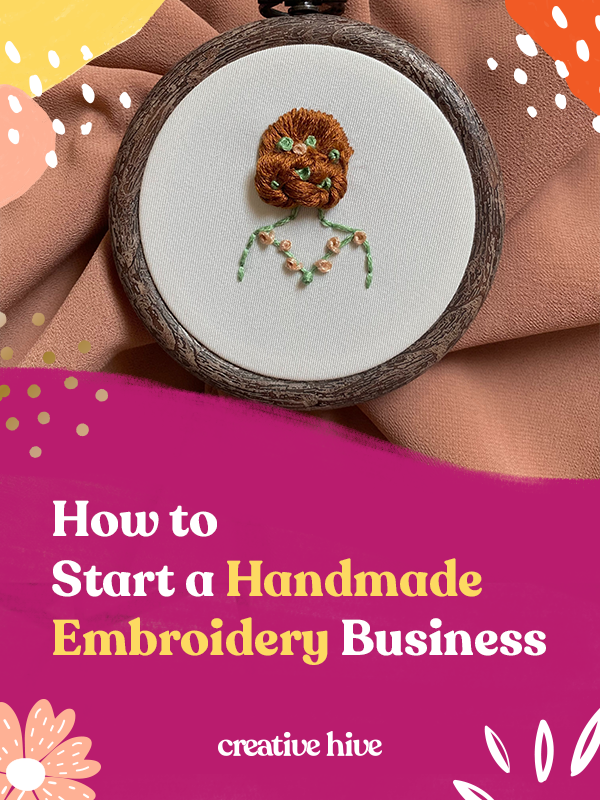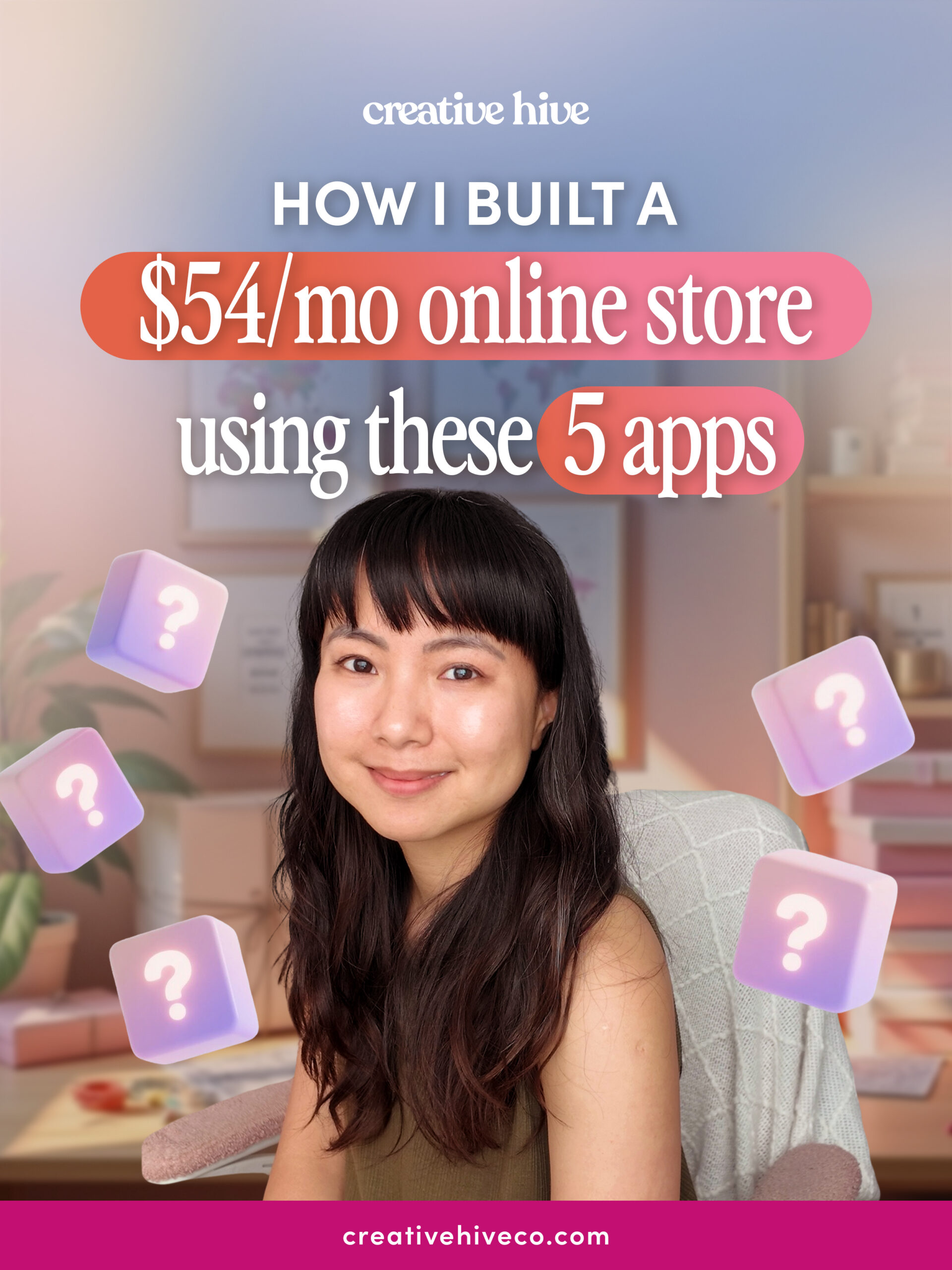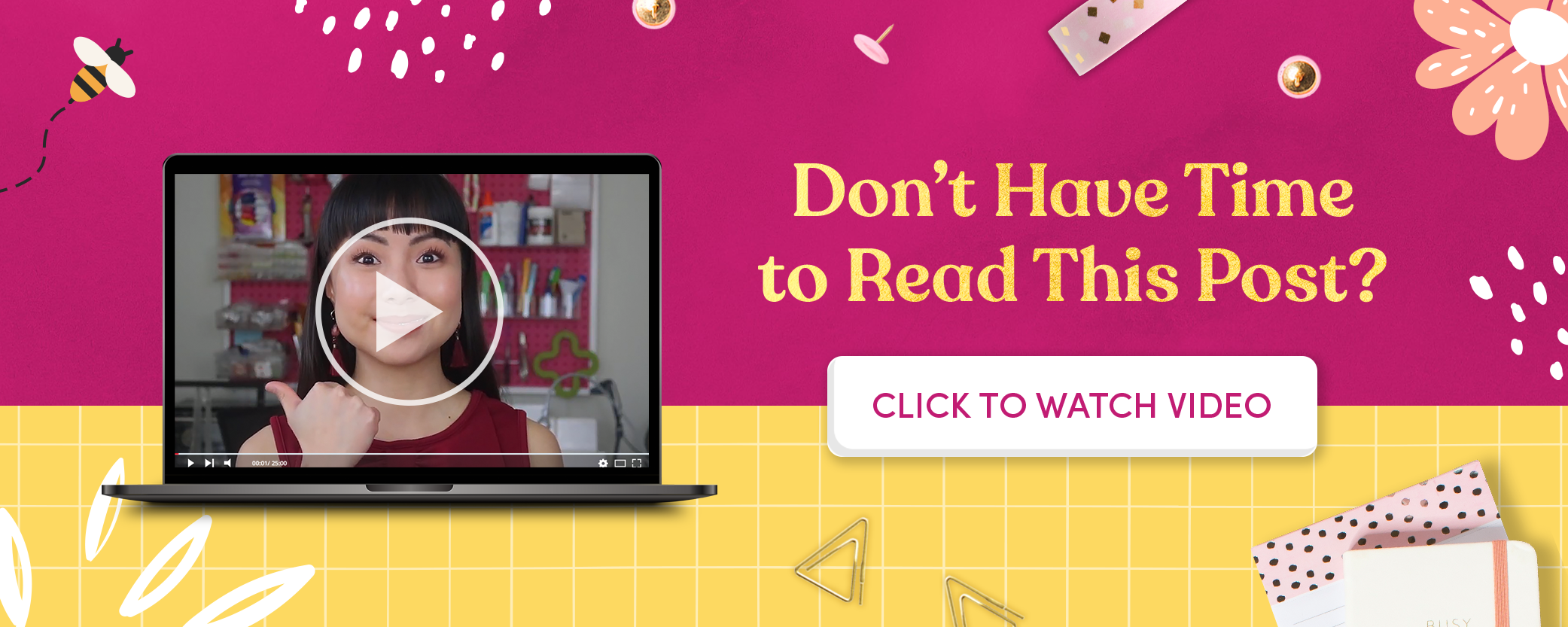I want to help you build a sustainable, profitable handmade business that makes you consistent income and sales. I only ever teach or recommend marketing, social media, pricing, production and branding tips that I’ve personally used successfully in my own 7-figure handmade businesses.
I'm Mei, from Los Angeles!
Read More
Popular Posts You'll Love
Looking for something?
Categories
starting a business
get more traffic
running a business
make more sales
branding
growing a business
mindset & productivity
podcasts
pricing & money
product photography
reviews
selling on etsy
selling on amazon
social media
selling wholesale
- Facebook0
- Twitter32
- Pinterest286
- 318shares
If you’re looking to start an embroidery business, you first need to find out if it’s actually profitable and worth your time.
Embroidery has been around for centuries and it’s easy to see why.
It’s classic, it’s beautiful, and it’s also so customizable that the options are limitless in terms of what you can make.
You can personalize items – like gorgeous wall hangings to baby blankets with the baby’s initials.
These things are popular and so in demand that you can really make bank.
The good news is that an embroidery business is dependable with a large built-in customer base that isn’t going anywhere.
Embroidery is a classic art form that people will always be interested in.
However, it’s also extremely competitive – especially as more and more people are trading in their office jobs for an embroidery machine during the pandemic.
I don’t want you to let the competition keep you from turning your passion for embroidery into a full-time business though.
With the right strategy and tools, you can absolutely stand out!
I run 3 creative online businesses and they each make me a full time income.
I’m here today to help give you some direction on your new business.
The market size value for the embroidery industry, which makes up about one third of the apparel design industry, is estimated at over $32 billion.
That’s expected to jump to $55 billion by 2025, according to Grandview Research.
It’s safe to say that with an already large market base that’s continuing to grow, this is one handmade business that artists can potentially make a lot of money from.
Especially if you can find a way to make your business stand out.
An embroidery business doesn’t require a lot of upfront costs to get started.
This low initial cost means you won’t be spending tons of money just to make your product in the first place.
Of course, an embroidery machine can get pricey.
But that will be the biggest expense you make when it comes to your actual product creation.
You can also make everything by hand which I know a lot of successful embroidery artists who do.
How to Start a Handmade Embroidery Business
We’ll do a price breakdown, further below, so you can see exactly how much you might expect to spend when starting out.
Your Niche
There are some cons to running this type of business.
It’s highly competitive.
If you search “embroidery” in Etsy, almost 2 million results come up.
It’ll be hard work to stand out among those millions of competitors.
But if you tap into the right niche and implement smart marketing strategies, you’ll have a much better chance of making it.
With that in mind, if you decide to start a handmade embroidery system of your own, the first thing you want to do is find your niche.
Finding your niche is SO important because this is what will make you stand out and give you focus.
People think that trying to make a ton of different products and appeal to everyone is what will help make sales.
That’s not the case.
You’ll only be confusing to other people.
Not only that but when you establish yourself in a specific niche, you become known for what you do.
So when people are looking for nerdy embroidered feminist art, they’ll know to go to you.
To find your niche, start by doing market research.
Look at what’s currently selling on Etsy or Amazon, or what people are engaging a lot with on Instagram to get a sense of what’s popular.
For embroidery, wooden hoop wall art and personalized baby wear are super trendy and therefore competitive.
But that doesn’t mean that you can’t tap into those markets, you just need to figure out how you can make your products different or better than what’s already out there.
Something to think about is personalization.
Instead of embroidering patterns onto a wooden hoop, can you embroider pet portraits?
Or instead of embroidering baby blankets, can you customize denim jackets with brightly colored flowers or business logos?
Embroidered masks could be something to explore as people are wanting to express their style with their face masks these days.
But I would also make sure you have an idea for how to expand your business now that the vaccine is out and masks might not be needed in the long term.
Choose a niche that you’re actually interested in because if you don’t, you’ll risk burning out.
When you’re working on something you’re passionate about – or something you can really take pride in – you’ll enjoy the process that much more.
When choosing your niche, you should also think in terms of your own interests.
If you’re a soccer fan, you can embroider jerseys for kids’ teams or unique hats and t-shirts for fans.
If you love dogs, you can embroider dog collars.
The key is finding a niche that there is already an audience for, but one that isn’t overly saturated.
You don’t want to choose something no one has ever heard of, because then no one will be searching for you and it’ll be really hard to find customers.
Getting Started
Once you choose the niche you want to tap into, it’s time to start making.
If you’re not a master of your craft, you won’t be able to sustain a loyal customer base and will probably crash and burn before you really make any money.
So, practice, practice, practice!
Yes, you will spend money on supplies for products that you may never sell.
But it’s worth it if it means you’re creating those first few test products before offering them for sale to the public.
When you’re practicing, you don’t need to be treading water in the deep end, trying to figure out everything on your own.
- Watch YouTube tutorials
- Read step-by-step embroidery blogs
- Invest in some professional education if you can
The more you can learn, the better your craft will be.
When I was starting out, I took the time to educate myself on everything polymer clay, so that I wasn’t making a poor quality product.
Setting Up Shop
Once you’ve mastered the craft, gather your supplies and set up a workplace.
You want to buy enough supplies for a single collection of products – maybe 10 to 15 unique items.
That way you can see what customers want to buy before you spend too much money and waste supplies making too much of a product that’s less popular.
You might think you know exactly what your customers will want, but you really don’t know until you get your work out there.
Don’t assume your favorite will be their favorite.
Supplies Needed for Starting Handmade Embroidery Business
For an embroidery business, the supplies you’ll need are pretty straightforward.
The biggest decision you’ll need to make is whether or not you want an embroidery machine, and which type to invest in.
It might be a good idea to buy a machine and not try to embroider everything by hand.
Without a machine, you are limiting your business.
You simply won’t be able to keep up with high demand and will be forced to sell far fewer products that take three times as long to make.
If you love embroidering by hand, you can still make a select number of customized hand-embroidered products from time to time.
But make sure these aren’t the most popular products you sell.
Embroidery Machines
So, which machine should you buy?
It really depends on what you want to make – there are machines that are better for patches, and some that are better for the really intricate stuff.
If you buy a machine with multiple needles, you’ll have to pay a lot more, but you will also be able to design more detailed, elaborate products faster.
The most highly recommended machine is the Brother PE800 5×7 Embroidery Machine, which costs around $1200.
If you don’t want to spend that much money, a less expensive option is the Brother SE600, which sells for around $600.
Keep in mind this machine is really designed for beginners more than for professionals.
Other supplies include:
- embroidery thread
- stabilizers and toppings
- fusible interfaces
- adhesive sprays
- disappearing ink pens
- embroidery snips
- ballpoint needles
- hoops
- fabrics
- items to embroider
- and computer software to create your designs
Altogether, depending on the products you choose, the cost could be anywhere between $1500 to a few thousand dollars.
That might be a bit on the high end, but don’t forget that you can start off by doing embroidery by hand until you can save up enough to buy a machine.
Your Website
Once you’ve set up your workspace and gathered your supplies, you can set up your own online shop!
Your website will be the center of your business.
Make sure you take the time to:
- create high-quality product photos (you can watch my video on taking product videos to learn how)
- choose a theme that you love
- and create a website that’s user friendly for customers
If you’ve seen my other videos, you know I recommend creating your website through Shopify.
Shopify allows you to be in control of your own business, so you don’t have to be a victim to the changing rules and search algorithms of Etsy or Amazon.
It also allows you to avoid having to share a percentage of your sales with them.
You can set up a shop on Etsy or Amazon, but I really don’t recommend relying on those for your sole income.
When you have your own site, you are giving yourself so much more freedom, and relying on no one but yourself is a recipe for long-term success and stability.
Your products also won’t be featured alongside a ton of your competitors’ products or risk getting lost in the feed.
Marketing
It might sound scary to build your own website.
You may be wondering how anyone will find it?
That’s where great marketing comes into play.
You’ll need to market your business if you want to build a customer base.
That’s true whether you’re selling on Etsy or on your own site.
You mine as well drive traffic to a site that’s all yours.
There are so many ways to market your product.
You can post on social media which everyone is doing right now.
Though, I’ve found that organic social media posts are a really slow and an unreliable way to market your product.
You’re relying on customers to search for your hashtag on Instagram and stumble upon your post among the others.
Not to mention, there’s a ton of competition on Instagram.
Paid ads on Instagram and Facebook are a lot more effective because they reach a targeted audience of people who might have an interest in your product.
This can add up though and you might not be able to afford to run ads all day every day in the beginning.
When I was starting out, I hired a number of ad agencies to take on my marketing for me.
I found that I was spending a lot of money for very little results so I would definitely avoid using an agency and learn how to do your own marketing.
Influencers
In my experience, the number one marketing strategy that is so underrated is influencer marketing and media outreach.
This is how one of my products ended up on an episode of Parks and Recreation.
When people see influencers that they love using a product, they connect with that product on an emotional level and deeply trust the review of the person using it.
Because of that, they’re so much more likely to make the purchase.
I know that reaching out to mega-influencers might not be realistic, especially when you’re just starting out.
But the good news is that you don’t need Kim Kardashian wearing your embroidered hat line in order to get the word out there.
There are thousands of influencers that aren’t Kim Kardashian who are very approachable.
And they’re eager to make new partnerships with small businesses to connect to their followers.
So, by helping you, they’re actually helping themselves, too.
You will have to provide the influencer with a free product so they can actually experience it for themselves.
You might not feel like it’s the best option at first, but let me tell you – it’s SO worth it.
When their followers see their favorite influencer sporting an embroidered product YOU made, they’ll come running.
Not only that but these influencers might be followed by bigger influencers with a larger number of followers.
That bigger influencer might see your product, fall in love with it, and want to help you spread the word about your shop as well.
My product was featured on Parks and Rec because a blogger posted about it and the Parks and Rec costume designer happened to see that post.
That was a huge day for my shop, and sales have been at that $200,000 level a year ever since.
Don’t limit yourself to just Instagram influencers either, you can reach out to YouTubers, bloggers, and magazine editors as well.
Starting a handmade embroidery business might feel intimidating, especially with so much competition.
But when you pick a niche, build an awesome Shopify website, and do outreach, you’ll be so much more likely to stand out, grab attention and get people to buy.
If you have an embroidery business, comment below about one thing you wish you knew when starting out.
Then check out my YouTube channel so you never miss out on the latest advice for handmade business owners.

Leave a Comment
Liked this article? Share it!
Unlock a Profitable Handmade Business
in Just 12 Weeks Without Using Etsy
or Social Media
FREE WORKSHOP
This workshop is for anyone who makes and sells a handmade or physical product, including jewelry designers, artists, paper designers, bath & body product makers and more!
What You'll Discover
The #1 mistake people make with Etsy & social media that causes shops to FLOP
The secret to making it with your handmade shop so it's no longer just a hobby
How to make sales in your handmade shop with ease so you can finally get to 6-figures
TAKE ME THERE
Your email address will not be published. Required fields are marked *
Leave a Reply Cancel reply
About
Blog
A Sale A Day
Student Login
Free Class
Contact
Terms
Become A Student
Watch On YouTube
Student Reviews
See My Handmade Shop!




Hi, thanks a lot for the eye opening tips.
My fear:
I love needlework esp surface handembroidery but how can my business survive in Nigeria with little value for hand embroidery?
Thanks.
Thanks for these valuable advices. am new in this field … ur advices soooo important thanks again
Mariam
Beirut-Lebanon
Thanku so much for detailed n valuable information.I am on a decision making stage whether I can start or not